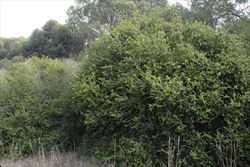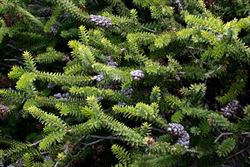Click on images to enlarge

infestation (Photo: Rob and Fiona Richardson)

habit (Photo: Rob and Fiona Richardson)

habit (Photo: Rob and Fiona Richardson)

younger branches with leaves (Photo: Rob and Fiona Richardson)

close-up of younger leaves (Photo: Rob and Fiona Richardson)

clusters of mature fruit (Photo: Rob and Fiona Richardson)

close-up of mature fruit (Photo: Rob and Fiona Richardson)
Scientific Name
Melaleuca diosmifolia Andrews
Synonyms
Melaleuca chlorantha Bonpl.Melaleuca foliosa Dum. Cours.Myrtoleucodendron diosmifolium (Andrews) Kuntze
Family
Myrtaceae
Common Names
coastal green bottlebrush, diosma-leaved honey myrtle, dotted melaleuca, granite honey myrtle, green bottlebrush, green flowered myrtle, green flowered paperbark, green honey myrtle, green honey-myrtle
Origin
Native to the coastal districts of southern Western Australia.
Naturalised Distribution
Naturalised in southern Victoria and also reported to be naturalised beyond its native range in south-western Western Australia.
Notes
Green honey-myrtle (Melaleuca diosmifolia) is regarded as an environmental weed in Victoria. This species is often cultivated in southern Australia because of its unusual greenish-coloured flowers. As well as replacing native species, green honey-myrtle (Melaleuca diosmifolia) increases fuel loads in invaded areas. This makes these areas more fire-prone, altering the fire regime and potentially impacting on the structure and integrity of the invaded community.
In Victoria, green honey-myrtle (Melaleuca diosmifolia) has invaded coastal heathlands, conservation areas and roadsides (e.g. remnant heathlands at Anglesea). It is also listed as an environmental weed in the Surf Coast Shire and the City of Hume. In Western Australia, green honey-myrtle (Melaleuca diosmifolia) grows naturally on granite outcrops along the south coast near Albany. However, it has also been reported to be escaping from plantings at Bluff Knoll in the Stirling Range National Park, about 100 km north-east of Albany.

